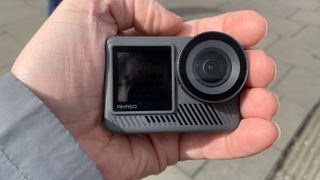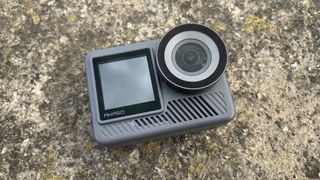The Akaso Brave 8 LE is a budget-friendly camera that’s perfect for those looking to capture action footage but who don’t want to spend the big bucks on a flagship model. The compact and modern design looks great, and feels really lightweight in the hand, although the downside of this is that the plastic construction, especially of the port hatches, left me concerned I was going to break it. Video and image quality are perfectly fine when filming in normal lighting conditions, but as soon as the light drops the sensor begins to struggle. The Brave 8 Lite is also let down by a lack of robust video stabilization, but at under $200 you’ll be hard pressed to find anything else that delivers this level of spec.
Pros
- +
Very affordable
- +
Super-small body
- +
Great companion app
Cons
- –
Flimsy plastic construction
- –
Struggles in low light
- –
Poor video stabilization
Why you can trust TechRadar We spend hours testing every product or service we review, so you can be sure you’re buying the best. Find out more about how we test.
Two-minute review
The Akaso Brave 8 Lite is a stripped-back version of the Brave 8. No surprises there. For a saving of $90 / £50, you’ll have to trade in the 1/2-inch sensor for a 1/2.3-inch alternative, and accept a drop in resolution from 48MP to 20MP.
As a result, this camera’s video and image quality are inferior to not only the Brave 8’s but that of other flagships such as the GoPro Hero 12 Black and the Insta360 Ace Pro. This is particularly noticeable in low-light conditions, a scenario that introduces so much noise that the footage oftentimes becomes unusable.
Before you rule out the Brave 8 Lite, though, you’ll actually get a range of features that are not available on the more expensive Brave 8, including HDR video, a longer runtime, and Hindsight. The last of these enables additional recording time prior to pressing the record button, just in case you were too late to start shooting.
I love the rubber casing on the body, something that not only makes the camera easy to grip but is also pleasant to handle. This finish is let down, though, by the cheap plastic port hatches, which feel like they’re going to break every time you open them. You’ll also have to be especially dexterous to figure out a way to open the microSD card hatch with only one hand.

The Brave 8 Lite is one of the smallest action cameras available, and will fit neatly into any bag or pocket. The abundance of additional cases means you can mount the camera on any surface, including a tripod, bike, or helmet. The metal case is particularly handy when you know you’re going to struggle to keep the camera free from knocks, although you can’t replace the battery when using this case.
There’s no shortage of creative shooting modes, such as timelapse, hyperlapse, slow motion, and HDR video. Not all of these are available at 4K, though, and the resolution must be dropped to get extreme editing capabilities with regards to slowing down and speeding up the footage.
All in all, the Brave 8 Lite is a very capable action camera that performs as well as most flagships did two or three years ago, and at a more affordable price than the Brave 8 it’s a great entry level choice.
Akaso Brave 8 Lite: price and release date
The Akaso Brave 8 Lite is available for $199.99 US / £189.99 UK / $319.99 AUS. This makes it $90 US / £50 UK / $80 AUS cheaper than the fully fledged Brave 8.
The Lite version has a smaller resolution, a slightly smaller sensor, and inferior slow-motion capabilities. On the flip side, over and above the full version you’ll get longer runtime, and HDR video functionality. If you’re happy with 20MP photo resolution and inferior low-light performance, the Brave 8 Lite is well worth the savings.
Akaso Brave 8 Lite: design
The Akaso Brave 8 Lite looks much like most other action cams, and the fact that it’s almost identical to the Brave 8 is to be expected.
The body measures 2.5 x 1.75 x 1.4 inches / 64 x 45 x 35mm. This makes it smaller than the likes of GoPro Hero 12 and Insta 360 Ace Pro, both of which are around 6mm larger in both width and height. The small body results in a very light overall weight of 4oz / 114g (including battery).
This lightweight body is wrapped in grippy gray rubber, which ensure that it stays securely in the hand, and also affords a reasonable degree of protection from knocks and scrapes.
Unfortunately, the hatches are of plastic construction, and they’re very flimsy. Even in the short amount of time that I was testing the camera I noticed that I was visibly damaging these parts, even with careful handling. The microSD card hatch is also incredibly difficult to open, and despite trying numerous times I couldn’t find a way to open this hatch with one hand.
The front of the unit is taken up by the lens and front-facing screen. The lens is prominent and aesthetically pleasing, with a removable guard that provides access to the lens itself for cleaning purposes. The 1.22-inch front screen is perfect for vlogging, but it isn’t large enough to provide much feedback on images beyond basic composition. It also lacks touchscreen functionality.
The rear 2-inch touch screen is adequate enough for cycling through settings and getting a rough idea of what the sensor is picking up. There’s room for a larger screen, though, which would really help, especially for reviewing footage and photos. For comparison, the GoPro Hero 12 has a 2.27-inch screen, which provides a much more pleasing experience.
Every action camera needs to be waterproof, and the Brave 8 Lite is rated to a depth of 33ft / 10m. That’s fairly typical, with the main outlier here being the Osmo Action 4, which is rated down to 60ft.
The camera’s interface is very easy to use, with the responsive touchscreen making it a joy to move through the menus. You’re not able to zoom into photos in review mode, however, which is a shame given the small screen size.
Akaso Brave 8 Lite: performance
The Akaso Brave 8 Lite performs as you’d expect for a sub-$200 action camera with a 1/2.3-inch sensor, and despite the inclusion of the aforementioned additional features over and above the Brave 8, in terms of video and image quality, the Brave 8 Lite doesn’t match up to more expensive models.
Its 4K video footage looks pretty good when captured in ideal lighting conditions. Colors are vividly and accurately reproduced, although images are unnecessarily high in contrast. The lens and sensor begin to struggle when filming scenes that have extreme light and darkness, and the camera fails to capture the full dynamic range of such challenging scenarios.
This is not a camera that’s made for filming in low-light conditions. An abundance of noise is introduced to dark areas, and while much of this can be removed in post without affecting image quality, the added step is a little annoying.
The wide-angle lens keeps distortions to a minimum, although as soon as you begin using the digital zoom you’ll notice a reduction in the image quality, especially in terms of noise levels. The maximum zoom setting, named ‘narrow angle’ in the camera introduces so much noise that, in my opinion, the footage becomes unusable.
The Brave 8 Lite offers a range of other shooting modes, including timelapse, hyperlapse, slow motion, and HDR video. The slow motion functionality is only available at 2.7K resolution and below, and the fact that it’s not available at 4K is disappointing. At 2.7K it’s possible to slow footage down by 4x, while reducing the resolution to 1080p makes it 8x slower.
Like several other action cameras, the Akaso Brave 8 Lite features a hyperlapse mode that enables you to create high-speed timelapse sequences. Footage can be sped up by up to 30 times, which allows for a flexible level of creativity.
Photo resolutions of 20MP and 12MP give users the ability to manage their storage space, but the larger size option falls some way short of the 27MP of the GoPro Hero 12 Black.
Stabilization of footage is where the Brave 8 Lite really struggles, as can be seen in the clip below. The clip was shot a bumpy road, and the camera seems unable to provide anywhere near enough stabilization to make the footage usable. This is less of a problem with slow-motion or hyperlapse footage, but if you want a more reliable setup then you’ll need to opt for something like the DJI Osmo Action 4.
Almost every action camera struggles to maintain a meaningful runtime, especially at 4K, and the Brave 8 Lite is no different, with the advertised runtime of 150 minutes only being available at 1080p. The battery is the same as the one in the Brave 8, so if you have both cameras, you’ll be able to swap batteries between them.
The Akaso app is far easier to use than the on-board interface. The menus are more streamlined, and the higher resolution video display makes it possible to get a clearer idea of what you’re filming. I prefer not to rely on an app when capturing footage, but for this camera, it became something of a necessity.
Should I buy the Akaso Brave 8 Lite?
Buy it if…
You like the look of the Brave 8 but you’re on a budget
At $199.99 / £189.99 the Brave 8 Lite is $90 / £50 cheaper than the fully fledged Brave 8.
You want a super-small action camera
The Brave 8 Lite is one of the smallest action cameras on the market, and it’s also very lightweight.

